
The Lyndon B. Johnson Space Center (JSC) is NASA's center for human spaceflight, where human spaceflight training, research, and flight control are conducted. It was renamed in honor of the late US president and Texas native, Lyndon B. Johnson, by an act of the United States Senate on February 19, 1973.

John Watts Young was an American astronaut, naval officer and aviator, test pilot, and aeronautical engineer. He became the ninth person to walk on the Moon as commander of the Apollo 16 mission in 1972. He is the only astronaut to fly on four different classes of spacecraft: Gemini, the Apollo command and service module, the Apollo Lunar Module and the Space Shuttle.

Robert Laurel Crippen is an American retired naval officer and aviator, test pilot, aerospace engineer, and retired astronaut. He traveled into space four times: as pilot of STS-1 in April 1981, the first Space Shuttle mission; and as commander of STS-7 in June 1983, STS-41-C in April 1984, and STS-41-G in October 1984. He was also a part of the Manned Orbiting Laboratory (MOL), Skylab Medical Experiment Altitude Test (SMEAT), ASTP support crew member, and the Approach and Landing Tests (ALT) for the Space Shuttle.
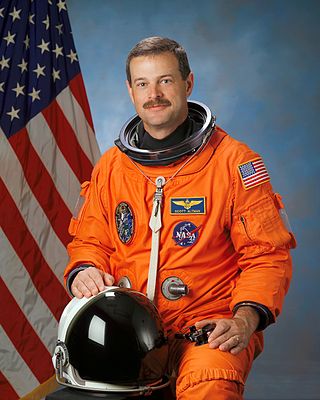
Scott Douglas "Scooter" Altman is a retired United States Navy Captain and naval aviator, engineer, test pilot and former NASA astronaut. He is a veteran of four Space Shuttle missions. His fourth mission on STS-125 was the last servicing mission to the Hubble Space Telescope. As of November 2022, he is the president of the Space operating group for ASRC Federal.

James Donald "Wxb" Wetherbee, is a retired United States Navy officer and aviator, test pilot, aerospace engineer, and NASA astronaut. He is a veteran of six Space Shuttle missions and is the only American to have commanded five spaceflight missions.

STS-38 was a Space Shuttle mission by NASA using the Space Shuttle Atlantis. It was the 37th shuttle mission, and carried a classified payload for the U.S. Department of Defense (DoD). It was the seventh flight for Atlantis and the seventh flight dedicated to the Department of Defense. The mission was a 4-day mission that traveled 3,291,199 km (2,045,056 mi) and completed 79 revolutions. Atlantis landed at Kennedy Space Center's Shuttle Landing Facility's runway 33. The launch was originally scheduled for July 1990, but was rescheduled due to a hydrogen leak found on Space ShuttleColumbia during the STS-35 countdown. During a rollback to the Orbiter Processing Facility Atlantis was damaged during a hail storm. The eventual launch date of November 15, 1990, was set due to a payload problem. The launch window was between 18:30 and 22:30 EST. The launch occurred at 18:48:13 EST.

Steven Alan Hawley is a former NASA astronaut who flew on five U.S. Space Shuttle flights. He is professor of physics and astronomy and director of engineering physics at the University of Kansas.

Richard Noel "Dick" Richards, , is a retired American naval officer and aviator, test pilot, chemical engineer, and a former NASA astronaut. He flew aboard four Space Shuttle missions in the 1980s and 1990s.
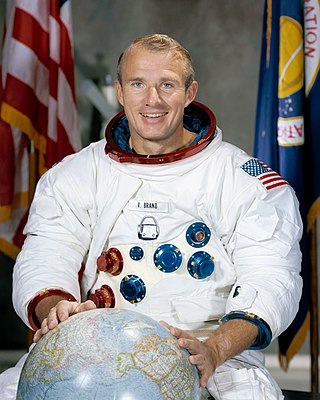
Vance DeVoe Brand is an American naval officer, aviator, aeronautical engineer, test pilot, and NASA astronaut. He served as command module pilot during the first U.S.-Soviet joint spaceflight in 1975, and as commander of three Space Shuttle missions.

Richard Oswalt Covey is a retired United States Air Force officer, former NASA astronaut, and a member of the United States Astronaut Hall of Fame.

STS-95 was a Space Shuttle mission launched from Kennedy Space Center, Florida on 29 October 1998, using the orbiter Discovery. It was the 25th flight of Discovery and the 92nd mission flown since the start of the Space Shuttle program in April 1981. It was a highly publicized mission due to former Project Mercury astronaut and United States Senator John H. Glenn Jr.'s return to space for his second space flight. At age 77, Glenn became the oldest person to go into space, a record that remained unbroken for 23 years until 82-year-old Wally Funk flew on a suborbital flight on Blue Origin NS-16, launching on 20 July 2021, which in turn was broken by William Shatner at age 90 on 13 October 2021. Glenn, however, remains the oldest person to reach Earth orbit. This mission is also noted for inaugurating ATSC HDTV broadcasting in the U.S., with live coast-to-coast coverage of the launch. In another first, Pedro Duque became the first Spaniard in space.

David Mathieson "Dave" Walker, , was an American naval officer and aviator, fighter pilot, test pilot, and a former NASA astronaut. He flew aboard four Space Shuttle missions in the 1980s and 1990s.

Michael Allen Baker is a retired captain in the United States Navy, former NASA astronaut, and the International Space Station Program Manager for International and Crew Operations, at NASA's Johnson Space Center. He is responsible for the coordination of program operations, integration and flight crew training and support activities with the International Partners.
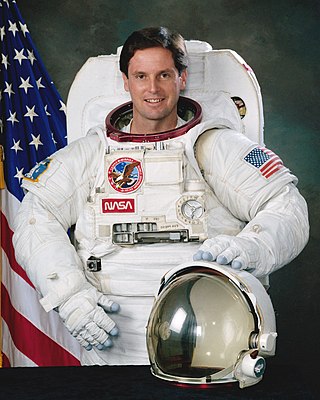
Gregory Jordan Harbaugh is an aeronautical/astronautical engineer and former NASA astronaut. He flew on four space shuttle missions as a mission specialist with responsibilities that included Remote Manipulator System (RMS) operation and Extravehicular Activity (EVAs). He performed three spacewalks during the shuttle missions including in support of repair/refurbishment of the Hubble Space Telescope.
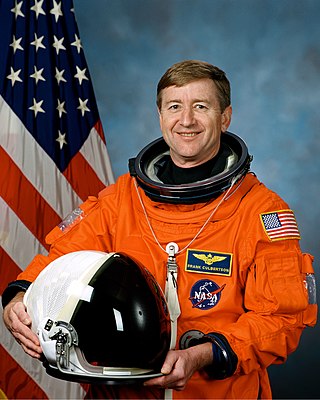
Frank Lee Culbertson Jr. is an American former naval officer and aviator, test pilot, aerospace engineer, NASA astronaut, graduate of the US Naval Academy, and member of the United States Astronaut Hall of Fame. He served as the commander of the International Space Station for almost four months in 2001 and was the only U.S. citizen not on Earth when the September 11 attacks occurred.
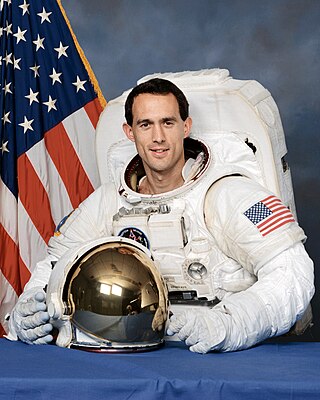
James Hansen Newman, Ph.D. is an American physicist and a former NASA astronaut who flew on four Space Shuttle missions.

Pierre Joseph Thuot is a retired United States Navy captain and NASA astronaut. He went into space three times, spending over 650 hours in space, including over 15 hours in three space walks. He is a former U.S. record holder for time spent on one spacewalk, and participated in the first three-person spacewalk.
Space Shuttle missions designated STS-3xx were rescue missions which would have been mounted to rescue the crew of a Space Shuttle if their vehicle was damaged and deemed unable to make a successful reentry. Such a mission would have been flown if Mission Control determined that the heat shielding tiles and reinforced carbon-carbon panels of a currently flying orbiter were damaged beyond the repair capabilities of the available on-orbit repair methods. These missions were also referred to as Launch on Demand (LOD) and Contingency Shuttle Crew Support. The program was initiated following loss of Space Shuttle Columbia in 2003. No mission of this type was launched during the Space Shuttle program.

STS-125, or HST-SM4, was the fifth and final Space Shuttle mission to the Hubble Space Telescope (HST) and the last solo flight of the Space Shuttle Atlantis and of any Space Shuttle. The launch of the Space Shuttle Atlantis occurred on May 11, 2009, at 2:01 pm EDT. Landing occurred on May 24 at 11:39 am EDT, with the mission lasting a total of just under 13 days.

Gregory Carl "Ray J" Johnson, , is a retired American naval officer and naval aviator, test pilot, aerospace engineer, and NASA astronaut. He spent his military career in both the regular United States Navy and the Navy Reserve. Johnson was the pilot on Space Shuttle mission STS-125, the final Hubble Space Telescope servicing mission.



















